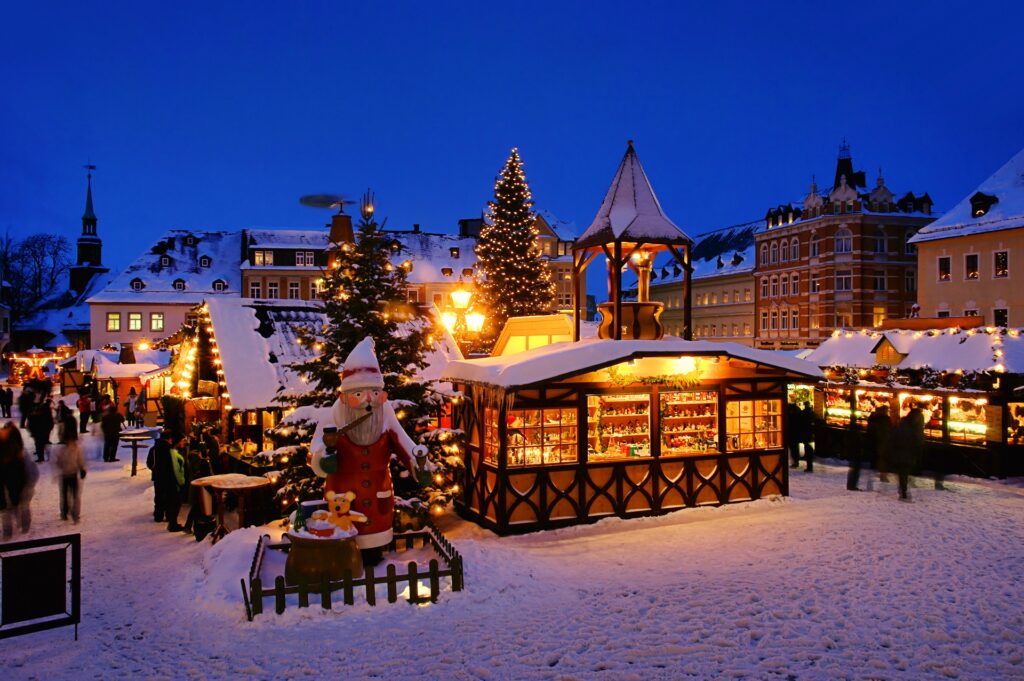Everyone celebrates the holidays differently, but across the globe, even the same holidays can take on an entirely different guise. From popular festivities like Germany’s annual Christmas Markets or donning an ugly sweater in the States, to lesser-known and unique customs like carving radishes in Mexico or feasting on KFC in Japan. Before you deck the halls and trim the tree, get a fresh take on the season with some inspiration from these holiday traditions.
AUSTRIA
Krampus
With curled horns, fangs, and hooves, the legendary figure of Krampus is an alarming-looking creature that appears during the Christmas season. Instead of giving out presents, the mythological figure, believed to have roots in pre-Christian, European traditions, is said to scare children who have misbehaved. Today, Krampus parades are held in Austrian villages through the month of December.
Explore tours to Austria >
ISRAEL
Sufganiyot (Jelly Donut)
Jewish communities around the globe feast on fried foods during Hanukkah, the eight-day festival of lights. The holiday marks an ancient miracle when a group of Jewish rebel warriors watched a day’s worth of oil stretch for more than a week. Fried foods serve as reminders of the event. And in Israel, one of the most beloved Hanukkah treats is sufganiyot. Sufganiyot are pillowy jelly-filled doughnuts topped with powdered sugar. This delicious traditional food invites endless innovation; with new variations on the tasty treat emerging every year.
Explore tours to Israel >
BAHAMAS
Junkanoo
Not to be confused with Carnival, the immensely popular street festival called Junkanoo is celebrated on December 26th and January 1st. Parades start around 2 a.m. and go until about 10 a.m the following day. Wearing elaborate costumes, Bahamanians shimmy across the island to the sound of cowbells, drums, and whistles. While the origins of Junkanoo are debated, many Bahamians trace the celebration back to the era when enslaved people used “days off” between Christmas and the New Year for roving parties.
UKRAINE
Spider Web Decorations
This tradition harks back to a fairy tale in which spiders decorated the tree of a family too poor to afford proper yuletide ornaments. The rising sun on Christmas morning makes the tree sparkle and glisten, similar to modern lights and tinsel. Today, pavuk (spiders) are still considered a sign of good luck in Ukraine. People often decorate their Christmas tree with homemade spider ornaments and artificial webs to invite good luck in the coming year.
JAPAN
Eating KFC
While Christmas isn’t a national holiday in Japan, in 1974, KFC launched a campaign that read “Kentucky for Christmas” and the country has never looked back. Today, if you want to celebrate Christmas in Japan with a “party barrel” from KFC, you better order it weeks in advance. It often comes with all the fixings, including Christmas cake.
Explore tours to Japan >
GERMANY
Christmas Markets
The earliest mention of Christmas markets can be traced to medieval Germany, although they likely appeared vastly different from today’s sprawling affairs. Dresden holds the honor of being the oldest, and its main one, Striezelmarkt, offers dozens of vendors, a carousel, Ferris wheel, and puppet shows. Other famed markets can be found in Nuremberg, Munich, and Stuttgart. Christmas markets now exist all around the world, but tourists still come every year to experience the original German markets.
MEXICO
Night of Radishes
December 23 marks the Night of the Radishes in Oaxaca, Mexico. This interesting tradition dates back to colonial times when the Spanish introduced radishes to this region of Mexico, which is well known for its wood carving traditions. Hundreds of carved vegetables are displayed for a radish carving contest, all depicting Christmas-themed or Mexican folklore scenes. Radishes are grown specifically for this event, but in the past, it was a simple radish carved by shopkeepers to attract customers. Today, it’s a three-day long festival that attracts thousands of spectators. Sounds rad(ish)!
ITALY
La Befana
On the eve of Epiphany, January 5th, Christmas gifts are delivered by an old witch named La Befana. In spite of her appearance, Befana is a kind witch who flies around the world on her broomstick delivering gifts to good children. Legend has it that she got lost on her way to see baby Jesus, arriving a week late with presents in tow. If you’ve behaved, you might receive toys or candy; if you haven’t, you’ll likely end up with a lump of carbone (coal).
Explore tours to Italy >
ICELAND
Thirteen Yule Lads
Meet the Icelandic Yule Lads, a mischievous pack of troll-like figures, each with their own distinct personality. During the 13 days leading up to Christmas, a different Yule Lad comes down from the mountains each night to give children gifts — or potatoes. Kids put their shoes out, and in the morning, they’ll find a small gift from the Yule Lad if they’ve been good, or a potato if they’ve been bad.
Explore tours to Iceland >
UNITED STATES
Ugly Christmas Sweaters
Many of the United States’ most visible holiday traditions, like Christmas trees and dreidels, arrived in the country with immigrants. In the 1950s, holiday-themed “jingle bell sweaters” began to catch on, but it wasn’t until the 2000s that ironic, self-consciously ugly attire became hip. These kitschy and comical garments have become an American tradition and you may find yourself invited to an “ugly sweater party”. The third Friday of December has even been declared National Ugly Christmas Sweater Day.
Explore tours in the United States >


